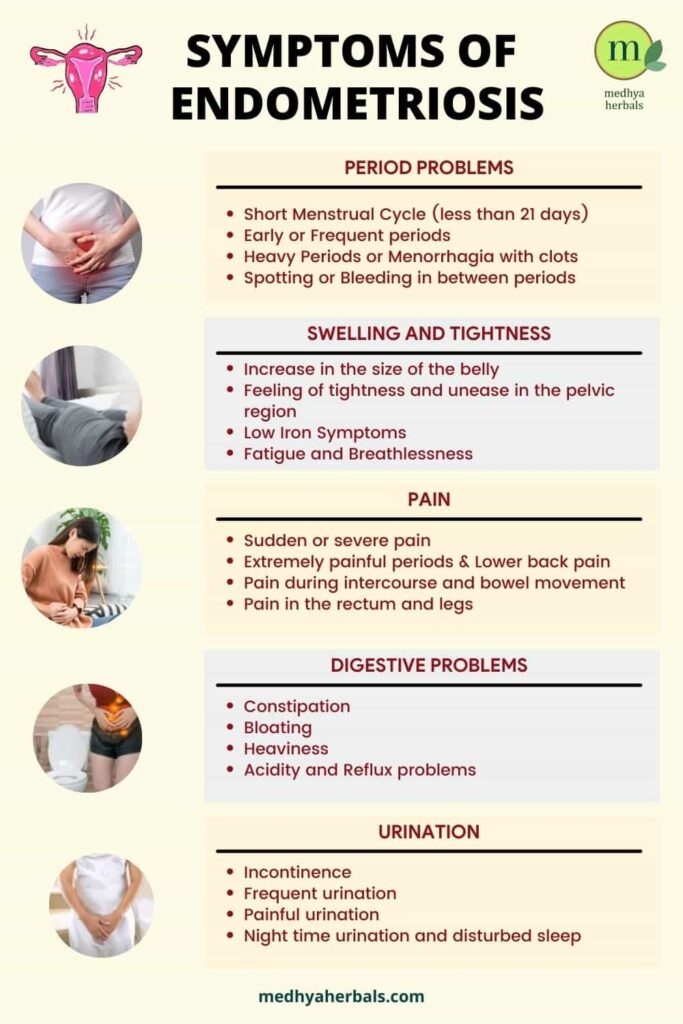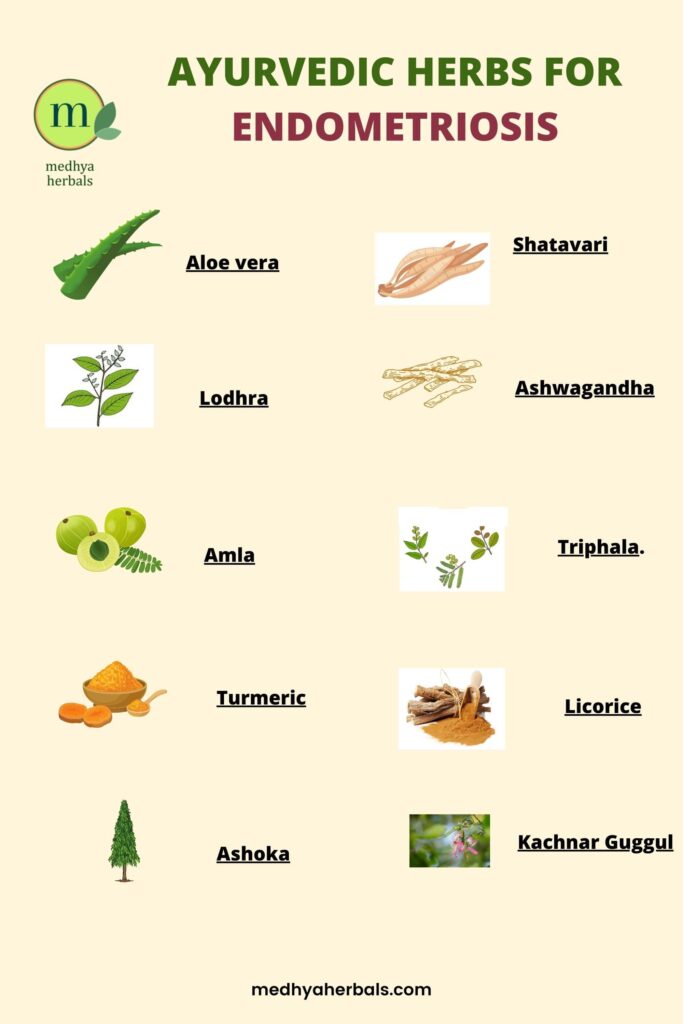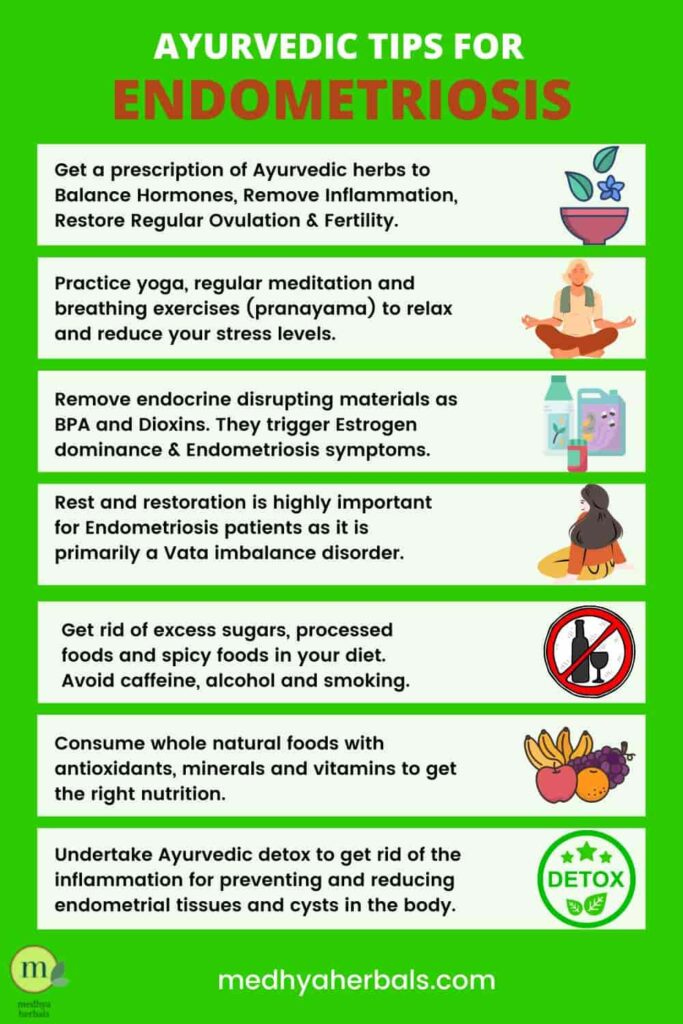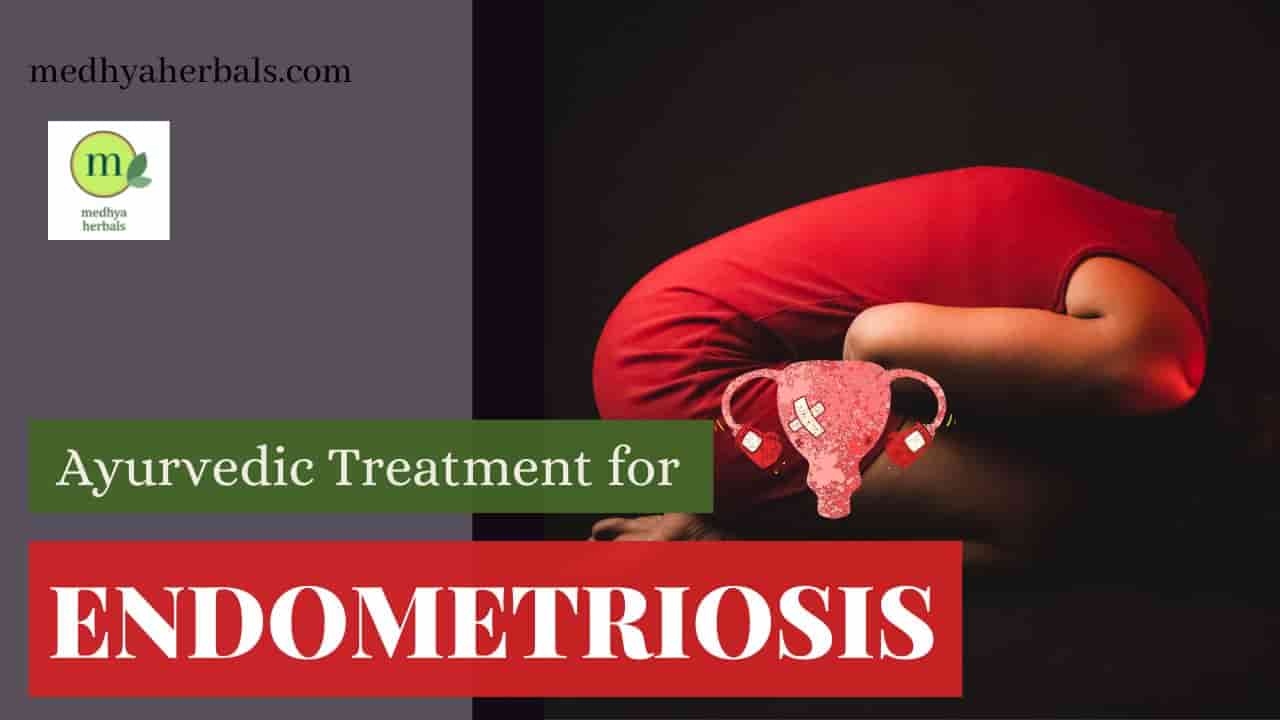Endometriosis is a gynecological condition that affects millions of women worldwide, and as an Ayurvedic doctor with years of experience in women’s health, I have seen first-hand how debilitating the symptoms can be. The condition occurs when the endometrial tissue (similar to the endometrium, the uterine lining) starts to grow outside of the uterine cavity, causing pain and discomfort.
If you’re one of the many women who suffer from endometriosis, you’ll be glad to know that there are highly effective Ayurvedic treatments that can help manage your symptoms naturally. In this article, I’ll be sharing some crucial information about endometriosis, including its causes, symptoms, and the most effective Ayurvedic treatments available.
So if you’re looking for a way to manage your endometriosis symptoms naturally, keep reading to learn more about how Ayurveda can help you to start your journey towards healing endometriosis naturally.

Understanding Endometriosis
Endometriosis occurs when the tissue that lines the uterus grows outside of it, leading to a range of symptoms such as recurrent and severe pelvic pain, inflammation and fertility problems. Endometriosis pain may radiate to the rectum or bladder and may intensify during sexual intercourse.
The abnormal growth of endometrial tissue is termed as endometrial lesions or endometrial implants. The walls of the pelvis or the surface of pelvic organs are the most common places for endometriosis lesions to occur.
However, endometriosis can also develop in other areas such as the uterus, ovaries, fallopian tubes, uterine and ovarian ligaments, bladder, and bowel. In ovaries, the endometrial implants result in the formation of chocolate cysts. In rare cases, endometriosis lesions have been found in more distant organs such as the diaphragm, lungs, and brain.
Endometrial implants can range in size and frequently take the form of nodules or cysts (also known as endometrial cysts or chocolate cysts). While the majority of endometrial cysts are brown, black, or blue colored, sometimes they can also be red, white, or clear.
Signs and Symptoms of Endometriosis
It is essential to understand that endometriosis symptoms can vary widely between individuals. While some may experience severe pain and discomfort, others may have no symptoms at all.
The chronic pelvic pain in endometriosis is usually non cyclical in nature, meaning it keeps on changing in intensity and duration. Also, the pain is not limited to menstruation. It can happen at anytime during the menstrual cycle. It is crucial to speak with a doctor if you experience unusual or persistent symptoms to ensure prompt diagnosis and treatment.

Following are some of the most common endometriosis symptoms
- Severe period cramps. The diagnosis of endometriosis should be considered especially, if a patient develops painful periods after years of pain-free menstrual cycles
- Excessive pain or cramping is experienced during sexual intercourse
- Lower back pain that worsens during menstruation
- Pain in the rectum and painful bowel movement may occur depending on the location of the endometrial implants
- Repeated miscarriages, infertility and inability to conceive
- Pain during urination, passage of red urine (during menstruation)
- Short Menstrual Cycle (less than 21 days) leading to Early or Frequent periods
- Heavy Bleeding or Menorrhagia
- Clotted menstrual blood flow
- Spotting or Bleeding in between periods
- Fever
- Fatigue
- Nausea and vomiting
- Poor Mental Health leading to Emotional Distress, Anxiety, Depression, and Mood Swings
- Digestive issues such as gas, bloating, stomach pain (endo belly), diarrhea or constipation that worsens during menstruation
Endometriosis should be considered in any woman (of reproductive age), who experiences severe pelvic pain that lasts for more than 6 months.
Ayurvedic View of Endometriosis
While there is no clear reference of endometriosis in Ayurvedic texts, the condition can be correlated to “vataja yonivyapad”, which means vata dosha imbalance of the reproductive organs.
Vata dosha is one of the three dynamic energies in Ayurveda that governs the circulatory such as movement of vital fluids such as blood, air, and nutrients, throughout the body. A sub dosha of vata, “apana vayu” is responsible for the eliminatory functions of the body, such as bowel movement and outward flow of menstrual blood.
When vata dosha is imbalanced, it can cause a disruption in the normal movement and circulation of blood in the pelvic region. This disruption can lead to the accumulation of toxins and waste materials in the body, thus triggering development of endometriosis.
How Endometriosis Develops and Grows
Both physical and mental factors can create vata dosha imbalance and lead to backward flow of apana vata. According to Ayurveda, excessive stress, too much consumption of cold, dry, raw, astringent and bitter foods, extreme physical activity, lack of sleep, too much travel (specifically air travel) and suppression of natural urges as urination, hunger and sneezing can increase the risk of development of endometriosis in women.
In addition, hormonal pills such as oral contraceptives for a longer duration can also disturb your hormonal balance, thus creating estrogen dominance and excessive growth of endometrial tissues.
Here’s how endometriosis develops:
Retrograde Menstruation causes Endometrial Implants
Apana Vayu (vata), a sub dosha of Vata dosha is responsible for downward flow of menstrual blood, urination, bowel movement and child birth. When Apana vayu is disturbed or blocked, it leads to irregular and backward flow of Apana vata “Udavarta”. Thus, upward flow of apana vata dosha leads to retrograde menstruation and provides conditions for endometrial implants to attach in the pelvic cavity or outside the uterus.
Pelvic Pain during Periods and Ovulation
Severe Pain is another characteristic of vata imbalance. When vata is disturbed, it leads to blockade, severe pelvic pain, abdominal and menstrual cramps. Also, regular menstruation and normal flow of egg (ovulation) is affected due to irregular flow of apana vata. This affects menstrual cycle and ovulation, leading to difficulty in conceiving, irregular menstrual flow, heavy menstrual bleeding or scanty periods with extreme pain and bloating.
Painful Sexual Intercourse
Additionally, an imbalance in the vata dosha can cause dryness in the body, leading to a lack of lubrication in the reproductive organs. This can cause pain and discomfort during sexual intercourse, which is a common symptom of endometriosis.
Advanced Stages of Endometriosis
Pitta dosha and Kapha dosha may also be present in the moderate to severe stages of endometriosis. This leads to burning sensation, diarrhea, acidity, a combination of Endometriosis and IBS symptoms, weight gain, lethargy, heavy menstrual bleeding with clots, and mucus in the stools or menstrual blood.
Endometriosis Ayurvedic Treatment: A Holistic Approach for Permanent Relief
The goal of endometriosis treatment in Ayurveda is to reduce inflammation, balance hormones, and strengthen the immune system, all of which can help alleviate the symptoms of endometriosis and prevent its recurrence.
Ayurvedic treatment for endometriosis typically involves a combination of dietary and lifestyle changes, herbal remedies, and therapeutic procedures like massage “abhyanga” and detoxification “panchkarma” therapy. This holistic approach is highly effective to completely cure mild to moderate stage endometriosis.
For severe stage endometriosis involving adhesions in the bowel, bladder and the uterus, Ayurvedic treatments can support to successfully manage the symptoms and significantly reduce pelvic pain, thus preventing surgery.
One key difference between Ayurvedic and Western treatments for endometriosis is their approach to managing pain. Western treatments typically involve the use of painkillers and hormone therapy to manage the symptoms, while Ayurvedic treatment for endometriosis focuses on reducing inflammation and balancing the body’s natural healing mechanisms to alleviate pain and other symptoms.
The Protocol for Endometriosis Ayurvedic Treatment
The first line of Endometriosis treatment is ‘Nidana Parivarjanam’ i.e. removal of the root cause. As we saw, vata imbalance triggers and spreads Endometrial implants. Therefore, Ayurvedic treatment for Endometriosis focuses on following steps involving vata dosha balance and fertility support:
1. Vata anuloman – Regulate apana vayu downward flow with herbal medicines, panchakarma and basti chikitsa, in specific uttar basti.
3. Treatment for Granthi/ gulama – Shrink endometrial cysts and remove chocolate cysts
4. Shophhar chikitsa – Improve immune system response and remove inflammation in endometriosis
5. Raktaprasadan – Improve circulation through pelvic cavity and remove the blockades for proper menstruation
6. Rasayana chikitsa – Rejuvenate the reproductive system for fertility and vitality
Rather than taking a one-size-fits-all approach, Ayurvedic doctors tailor their treatments to the unique needs of each patient based on their individual body type and symptoms. This personalized treatment approach ensures that the treatment is effective in providing permanent relief from the condition.

Ayurvedic Medicine for Endometriosis Treatment
Ayurvedic medicines have anti-inflammatory, analgesic, and hormone-regulating properties that are highly effective to reduce pelvic pain, regulate menstrual cycle and promote fertility in endometriosis.
Here are some of the Ayurvedic medicines commonly used for endometriosis treatment:
- Ashwagandha: Ashwagandha is an adaptogenic herb that helps the body cope with stress. It has anti-inflammatory properties and can help reduce pain and inflammation associated with endometriosis. Ashwagandha also improves the overall reproductive health of women.
- Shatavari: Shatavari is a female reproductive tonic that helps regulate hormones and improve fertility. It has anti-inflammatory properties, thus it is very useful to reduce pain and inflammation associated with endometriosis. Shatavari is also known to improve the overall reproductive health of women.
- Guggulu: Guggulu is a resin that is extracted from the Commiphora mukul tree. It controls the growth of endometrial cysts and helps to reduce chocolate cysts in endometriosis. Guggulu is also known to improve the overall health of the reproductive system.
- Turmeric: Turmeric is a powerful anti-inflammatory herb that is commonly used in Ayurvedic medicine. Curcumin, the active ingredient in turmeric, helps reduce inflammation and pain associated with endometriosis. It also has anti-oxidant properties that help prevent cell damage and promote healing.
- Triphala: Triphala is a combination of three fruits – amla, haritaki, and bibhitaki. It is a natural detoxifier that helps cleanse the body of toxins. Triphala is also known to improve digestion and regulate hormones, which can help reduce the symptoms of endometriosis.
- Dashmoolarishta: Dashmoolarishta is an Ayurvedic tonic that is commonly used for gynecological problems. It has anti-inflammatory properties and can help reduce pain and inflammation associated with endometriosis. Dashmoolarishta is also known to improve the overall health of the reproductive system.
Panchakarma for Endometriosis: Deep Cleansing
Panchakarma, the herbal detoxification method in Ayurveda, is an effective holistic treatment for endometriosis. Along with reducing painful symptoms of endometriosis, Panchakarma also helps in long-lasting rejuvenation and health benefits.
All phases of Panchakarma are beneficial in managing endometriosis, and the use of medicated purgation or herbal enema helps to eliminate toxins and restore the balance of the vitiated vata dosha. In addition, deep cleansing in panchakarma balances digestive and metabolic fire “Koshthagni”, which contributes to overall well-being.
Uttar Basti: Herbal Enema
Basti refers to enema and uttar basti refers to enema of the uterus. Herbal oils and concoctions are used to perform uttar basti. It helps to regulate the apana vata (responsible for working of reproductive system) and facilitates regular ovulation. Uttar Basti helps to strengthen the uterus and boosts fertility by supporting successful implantation of the fertilized egg.
Virechana (Cleansing)
It refers to the cleansing procedures that support the health of the liver, regular bowel movement and flush out toxins. Virechana is primarily targeted to balance the Pitta Dosha.
Vamana (Vomiting)
It is really helpful in establishing hormone balance and removing the blockade in body channels. Thus, Vamana helps to bring good flow of hormones and induces regular ovulation.

Endometriosis Diet Tips
Poor diet and dietary habits create nutritional deficiencies and toxin buildup in the body. These are the two primary causes of Endometriosis, Hence, when you improve your diet, you also improve your chances of finding relief from Endometriosis symptoms. Here is a detailed post on endometriosis diet, where you can also grab a free download of 1 week of endo diet plan.
Best Foods to eat for Healing Endometriosis
- Prefer smaller meals during the day and do not hold hunger. Always take timely meals at fixed time everyday.
- Eat freshly prepared healthy meals at the right times.
- Take a lot of fruits and vegetables, and a lot of high-fiber foods too.
- Favor ghee, nuts like almonds, walnuts, pecans, flax seeds, sunflower seeds and pumpkin seeds, buttermilk, avocado, beets, lentils.
- Take warm and unctuous foods such as porridge, curries, gruel, and soups.
- Include spices and herbs to maintain healthy digestive fire and to get the micro nutrients.
Worst Foods that you should avoid in Endometriosis
- Reduce your consumption of red meat and deep-fried foods.
- Reduce your intake of dairy, except curd or buttermilk.
- Avoid sugar as much as you can. You can go for honey as an alternative sweetener.
- Reduce and remove caffeine, alcohol and any other stimulants from your meals and daily routine.
- Remove chili and peppers from your diet. Both of these cause excessive stimulation and vata aggravation
- Remove cold temperature foods and drinks.
- Limit or stop raw foods such as salads.

Ayurvedic Lifestyle Tips for Endometriosis Treatment
Ayurvedic lifestyle tips provide guidance daily routine that helps to establish hormone balance mental wellness. Here’s what you should do:
- Manage and reduce stress levels by either avoiding stressful activities or by better planning. Stress is one sure way to get your hormones out of whack.
- Practice regular meditation and breathing exercises (pranayama) that will help you to relax and reduce your stress levels.
- Reduce your exposure to endocrine disrupting materials such as BPA and Dioxins. They trigger Estrogen dominance and make you more prone to Endometriosis symptoms.
- Restrict your use of hormone-based contraceptives. If you can, avoid them completely.
- Avoid alcohol and smoking altogether. They are highly drying, disturb dosha balance and lead to toxin build up in the body.
- Abhyanga or regular massage will help to improve circulation in the body
- Don’t eat junk food. Eat healthily and avoid getting hungry so that you can better resist the temptation to eat junk food.
- Keep a regular, again, regular, sleep pattern in the night. Learn here on Ayurvedic guidelines for good sleep.
- Try not to sleep in the day so you don’t break your sleep cycles.
- Regular exercise to promote strength and balance.
- Avoid excessive exercise and stressful physical activity.
- Rest and restoration is highly important for Endometriosis patient as it is primarily a Vata imbalance disorder. So, always maintain balance and don’t go over the board.
Conclusion
Below testimonial and endometriosis success story truly reflects how Ayurveda can transform lives of women and give them happiness of bearing a child without needing for invasive treatments.
“I had been dealing with endometriosis for years, and the pain was excruciating. I tried everything, from painkillers to surgeries, but nothing seemed to help. It felt like a never-ending cycle of discomfort and despair. That’s when I came across Ayurvedic treatment for endometriosis at Medhya Herbals, and it was a game-changer. Dr. Bansal’s treatment was personalized to my needs, and he took the time to understand my concerns and health symptoms. The remedies he prescribed not only helped manage my pain, but they also improved my overall well-being. And the best part? Within just a few months of treatment, I was able to conceive naturally, something I had given up hope on. I can’t recommend Dr. Bansal and Medhya Herbals enough. If you’re dealing with endometriosis or any other reproductive health issues, don’t give up hope. Ayurvedic treatment, combined with Dr. Bansal’s expertise, can make all the difference.” ~ Emily Brown
Ayurveda offers a safe and natural approach to manage and treat fertility disorders as Endometriosis and Adenomyosis. One of the best points about Endometriosis treatment with Ayurveda is that there are no side effects. What you experience with Ayurveda is a complete rejuvenation of body and mind.
At Medhya Herbals, we have observed 60-70% reduction in endometriosis pain within 3-4 weeks of starting endometriosis treatment. Additionally, our patients in advanced stages of endometriosis could naturally conceive within 6-7 months even after multiple failed rounds of IVF and IUI before they started Endometriosis treatment with Medhya Herbals.
Consult with Medhya’s Ayurvedic Doctor to get your personalised health plan involving prescription for Ayurvedic medicine, diet, yoga and lifestyle guidelines.
FAQ
How fast does endometriosis spread?
Endometriosis is a perplexing condition that varies significantly among individuals. The speed at which it progresses or spreads can differ widely from one woman to another. Some women might experience a rapid spread of the tissue, leading to increased pain and symptoms within a short period, while others may have a more gradual progression over several years. Factors influencing its spread include hormonal changes, genetic predispositions, and immune system responses. It’s essential to note that the severity or stage of endometriosis doesn’t always correlate with the intensity of pain or symptoms. Some women with mild endometriosis might experience severe pain, while others with advanced stages might have minimal symptoms. Regular check-ups and early diagnosis can help in managing and monitoring the progression of the condition.
What is endometriosis called in Ayurveda?
In Ayurveda, endometriosis doesn’t have a direct equivalent term as the ancient texts describe conditions based on their symptomatic manifestations and imbalances in the body’s doshas. However, many Ayurvedic practitioners correlate endometriosis with “Vataj Yonivyapad,” a category of reproductive disorders caused predominantly by the imbalance of the Vata dosha. The symptoms of Vataj Yonivyapad, such as pain and irregular menstruation, resonate with many of the symptoms experienced by those with endometriosis. By understanding the condition in this framework, Ayurveda offers therapeutic approaches that aim to balance the aggravated doshas, especially Vata, to provide relief and holistic healing.
Can endometriosis be cured by Ayurvedic Treatment?
Ayurveda offers a holistic approach to managing endometriosis by targeting the underlying imbalances in the body’s doshas. While Ayurvedic treatments, including herbal remedies, dietary adjustments, and lifestyle changes, can significantly alleviate the symptoms and improve quality of life, they may not provide a complete “cure” for endometriosis. Many women find relief and better symptom management through these traditional methods. However, it’s essential to understand that Ayurveda focuses on holistic healing and symptom control rather than a definitive eradication of the condition. Consulting with Ayurvedic practitioners in conjunction with conventional medical professionals is always recommended to determine the best individualized treatment approach.
Does endometriosis go away with age?
Endometriosis is a chronic condition, and while it doesn’t necessarily “go away” with age, its symptoms can change over time. Many women find some relief from endometriosis symptoms after reaching menopause since the body’s production of estrogen, a hormone that stimulates endometrial growth, decreases. Without this hormonal stimulation, the endometrial tissue growth outside the uterus may reduce, leading to a decrease in symptoms. However, it’s crucial to understand that while menopause might offer relief for some, others continue to experience symptoms even after their menstrual cycles have stopped. This persistence can be due to residual endometrial lesions or the use of hormone replacement therapies. Always consult a healthcare professional for guidance specific to individual circumstances.
Can ginger heal endometriosis?
Ginger, a potent anti-inflammatory and antioxidant herb, has been revered in traditional medicine for its myriad health benefits. Recent studies have suggested that ginger might help alleviate some symptoms of endometriosis, primarily due to its ability to inhibit the production of pro-inflammatory compounds in the body. Additionally, ginger can help in reducing menstrual pain, a prominent symptom for many with endometriosis. While ginger might offer symptomatic relief and potentially reduce inflammation associated with endometriosis, it’s important to understand that it’s not a cure. Incorporating ginger into one’s diet or as a supplement can be part of a holistic approach to managing endometriosis, but always consult with a healthcare professional before making any significant changes to treatment plans.
References
- Ayurvedic Treatment Protocol for Chronic Pelvic Pain in Endometriosis
- Rani A, Sharma PK, Singhal P, et al. Ayurvedic management of endometriosis: A case study. J Ayurveda Integr Med. 2018;9(4):299-301.
- Sharma P, Sharma JD, Patil SB, et al. Ayurvedic approach in the management of endometriosis: A case report. Int J Res Ayurveda Pharm. 2017;8(2):120-122.
- Sharma S, Sharma JD, Sharma P, et al. Ayurvedic management of endometriosis: A case study. Ayu. 2016;37(4):297-299.
- Kapoor S, Kapoor M, Kakkar V, et al. Ayurvedic management of endometriosis: A case study. J Ayurveda Holist Med. 2017;5(1):18-21.
- Parihar A, Singhal M, Sharma P, et al. Ayurvedic management of endometriosis: A case report. J Ayurveda Integr Med. 2018;9(1):57-60.
- Dixit AK, Mehta S, Gupta SK, et al. Ayurvedic management of endometriosis: A case report. Int J Ayurveda Res. 2010;1(1):44-46.
- Rani P, Parihar A, Kaushik R, et al. Ayurvedic management of endometriosis: A case report. J Ayurveda Integr Med. 2019;10(2):135-138.
- Mohapatra N, Pati PK, Panda N. Ayurvedic management of endometriosis: A case report. J Ayurveda Integr Med Sci. 2020;5(2):180-183.
- Sharma P, Sharma JD, Sharma S, et al. Ayurvedic management of endometriosis: A case study. Ayu. 2015;36(2):197-200.
- Deshpande SR, Deshpande NR. Ayurvedic management of endometriosis: A case report. J Ayurveda Holist Med. 2016;4(4):36-39.


Can ayurveda based treatment be undertaken in parallel with the birth control pill based treatment ? Are there any side effects of having them both in parallel ?
Hello! Yes, you can take it in parallel. However, we wean off our patients from birth control pills as they also create lot of hormonal issues which eventually aggravate the pain and inflammation in Endometriosis.